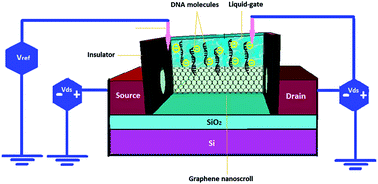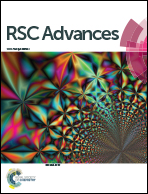Analytical prediction of liquid-gated graphene nanoscroll biosensor performance†
Abstract
The latest discovery of the graphene nanoscroll has provided enormous new stimuli to carbon nanoresearch. Due to its one-dimensional structure and tunable core size, the graphene nanoscroll is suitable for nanoscale applications such as in nanotransistors, and biosensor devices. DNA sensing is critical in the identification of the genetic risk factors associated with complex human diseases, and continues to have an emerging role in therapeutics and personalized medicine. This paper presents the analytical model of liquid-gated field effect transistors (LGFETs) for zig-zag graphene nanoscrolls (ZGNSs) inspired by carbon nanotube behavior when exposed to DNA molecules. First of all, in order to gain physical insight into GNS-based devices, the conductance of GNSs is analytically modelled. Based on the sensing mechanism of the DNA sensor, GNS controlling elements (ηGNS and εGNS) are proposed and the behavior of LGFETs-based GNS nanomaterial in the presence of DNA molecules is predicted to get a greater insight into the rapid development of DNA sensors and their application. Because of the channel-doping effect due to the adsorption of the DNA molecules, the conductance of the channel is altered. On the other hand, the applied voltage effect in the form of tilted electron energy levels is utilized in the form of normalized Fermi energy variation which is used in the sensor modelling. This study emphasizes the promising nature of carbon nanoscrolls for a number of electronic device applications.


 Please wait while we load your content...
Please wait while we load your content...